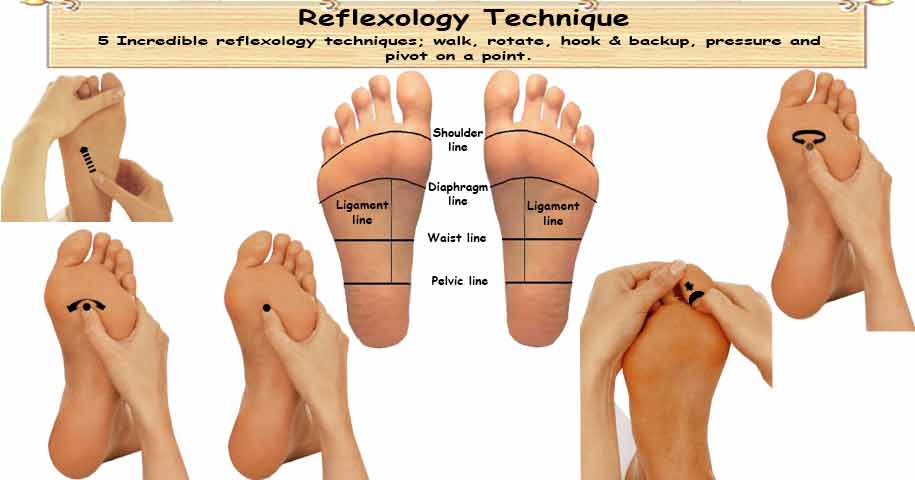Standard reflexology terms are transverse zones, foot aspects, and crystal deposits. Reflexology manipulation techniques are walking, rotating, hook & back up, pressing, and pivot on-a-point techniques.
5 Transverse lines in Reflexology
Five transverse lines are on the plantar aspect, they are
- The shoulder line located below the bases of the toes. Head, occipital, pituitary, inner and outer ear, teeth, jaw, sinus, eye, Eustachian tube, throat, and shoulder reflex points or areas are above this shoulder line.
- Diaphragm line is below the metatarsal base. The skin is darker around the metatarsals. Lungs, thyroid, esophagus, hiatus hernia, pancreas, and gallbladder reflexes are present between shoulder and diaphragm line.
- The Waistline differs from person to person; located in the narrowest foot spot similar to a waist! Kidney, adrenal, stomach, liver, spleen, transverse colon, hepatic and splenic flexure reflexes and part of small intestines are present between diaphragm and waistline.
- The pelvic line is between anklebones to heel base on either side of the foot. Ascending and descending colon, part of the small intestines and bladder are present between the waist and pelvic line.
- Ligament line runs down from the junction between big and first toes.
Aspects of the foot
According to reflexology, the foot comprises four elements.
- Dorsal is the upper-side foot.
- Plantar is the underside foot (sole). When standing, it rests over the ground.
- Medial is the inner side foot. The area between the big toe and the heel.
- Lateral: the outside side foot. The area between the little toe and heel.
Blockage by crystal deposits
Crystals is a sugar/sand-like grains on the reflexes. It indicates uric acid or calcium deposits in the respective part of the body. An experienced reflexologist can diagnose congestion in reflex areas; by the existence of crystal deposit in the nerve endings on foot. Disperse these deposits by work over the crystals. If there is any pain/discomfort, lower the applied pressure. The presence of crystals, pain, or discomfort indicates an out of balance. It suggests the present problem or future problem.
If the lungs become weak, their normal muscular function drops. In the specific reflex, the existence of crystals indicates the weakness. A minimal blockage is enough to cause a noticeable lack of lungs circulation. Due to this, there is a lack of fresh blood, oxygen, and nutrients delivery.
By applying gentle pressure, crystals can break, dissolve, and expel from the body. If there are an excess of crystals, it takes longer to break. A sensitive reflex point indicates weakness or imbalance of an organ or gland. Reflexology can strengthen organs; thus, help to avoid forthcoming illness.
5 Incredible reflexology techniques
Below are the five most frequently used methods in reflexology:
Walk technique
Thumb walk is the most used reflexology movement. Use thumb or finger to walk forward in a crawling action similar to a worm. During walking, taking one step at a time called a bite. Walking helps to locate the crystals (blockage) in a reflex; additionally, it disburses (unblock). Before doing thumb-walk; make sure that the nails are short without rough edges.
Flexing and straighten the first joint of the thumb or index finger, forms a walking movement. Walking has different names; they are, thumb walk (walking by thumb), finger walk (walking by finger), and bites. Thumb walk is a brief pressure, followed by a short relaxation without losing skin contact. Pressure and relaxation applied with tiny intervals help treat every reflex point.
Circle or Rotating technique
Using the thumb or finger, make a circular or rotating movement with firm pressure. Apply tiny rotating motion to the reflex point for three times, and then make a tender circle with inward pressure. Do not rub the skin; instead, using the tissue under the skin to form a ring.
The rotation technique helps to break the underlying crystal (uric or calcium deposit) formed around the nerve endings. This technique stimulates the reflex and starts the body's self-healing process.
Hook & Backup
The hook & backup is an advanced technique. Thumb-walk to reach specific reflex and then hook & backup the point. Hook method should have to do using the thumbs. Use the flat surface of the thumb, to apply pressure.
Flex the thumb to apply pressure in a vertical (90-degree) angle to the reflex point. Pull the thumb back to the center of the hand; do not forget to apply gentle pressure. Do this by dragging the tissue beneath the skin.
The hook & backup technique is suitable for deep reflex points hidden under the tissues such as the pituitary, pineal, ileocecal valve, appendix, and sigmoid colon.
Pressure
Press technique is to apply a firm pressure; should not push hard or dig. While pressing, do one or two minutes of breathing awareness.
How to do breathing awareness? Close the eyes and concentrate on the breathing (inhale & exhale); this brings quietness to the body and mind.
Pressing produces warm and lower congestion. Warmth shows the increased energy flow; this improves the performance of the specific organ reflex.
Pivot-on-a-point technique
On the reflex point, place flexed thumb as a pivot; then rotate the foot using another hand. The pivot-on-a-point method is useful for work on the diaphragm, solar plexus area, and adrenal glands.

